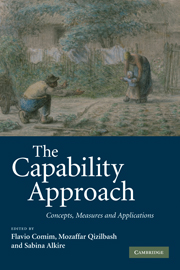Book contents
- Frontmatter
- Contents
- List of figures
- List of tables
- List of contributors
- List of acronyms
- Acknowledgements
- Introduction
- 1 Using the capability approach: prospective and evaluative analyses
- PART I Concepts
- PART II Measures
- 7 Do concepts matter? An empirical investigation of the differences between a capability and a monetary assessment of poverty
- 8 Social exclusion in the EU: a capability-based approach
- 9 Complexity and vagueness in the capability approach: strengths or weaknesses?
- 10 Operationalising Sen's capability approach: the influence of the selected technique
- 11 Operationalizing capabilities in a segmented society: the role of institutions
- PART III Applications
- Index
- References
8 - Social exclusion in the EU: a capability-based approach
Published online by Cambridge University Press: 22 September 2009
- Frontmatter
- Contents
- List of figures
- List of tables
- List of contributors
- List of acronyms
- Acknowledgements
- Introduction
- 1 Using the capability approach: prospective and evaluative analyses
- PART I Concepts
- PART II Measures
- 7 Do concepts matter? An empirical investigation of the differences between a capability and a monetary assessment of poverty
- 8 Social exclusion in the EU: a capability-based approach
- 9 Complexity and vagueness in the capability approach: strengths or weaknesses?
- 10 Operationalising Sen's capability approach: the influence of the selected technique
- 11 Operationalizing capabilities in a segmented society: the role of institutions
- PART III Applications
- Index
- References
Summary
Introduction
Since the late 1980s, in the political discourses of several European countries the term ‘poverty’ has been gradually substituted primarily by the term ‘social exclusion’ and, to a lesser extent, by the terms ‘social disintegration’ and ‘social marginalisation’. Comprehensive definitions of ‘social exclusion’ used in the academic literature interpret it as the denial of social, political and civil rights of citizens in society or the inability of groups of individuals to participate in the basic political, economic and social functionings of the society [Silver (1994), de Haan (1998)]. In practice, though, policy makers as well as a number of social scientists in EU member-states seem to interpret ‘social exclusion’ as ‘exclusion from the labour market’, ‘acute poverty and material deprivation’ (or both) or, less frequently, ‘inability to exercise basic social rights’ [Mayes et al. (2001), Atkinson et al.(2002)]. Few empirical studies investigating aspects of social exclusion can be found in the literature and, among them, there exists little agreement regarding its proper operationalisation.
This chapter builds on earlier work of the authors [Tsakloglou and Papadopoulos (2002a, 2002b)] and attempts to outline a methodology for the identification of population members at high risk of social exclusion based on Sen's concept of capability failure, using the information of the European Community Household Panel (ECHP).
Social exclusion and capabilities
Earlier studies of social exclusion claimed that ‘poverty’ and ‘social exclusion’ differ in two fundamental respects: ‘poverty’ is unidimensional since it is concerned only with lack of income, whereas ‘social exclusion’ is multidimensional since it is related to a broad range of aspects of deprivation and, further, ‘poverty’ is a static concept whereas ‘social exclusion’ is a dynamic concept [Berghman (1995)].
- Type
- Chapter
- Information
- The Capability ApproachConcepts, Measures and Applications, pp. 242 - 267Publisher: Cambridge University PressPrint publication year: 2008
References
- 10
- Cited by



